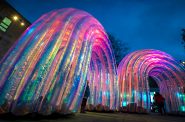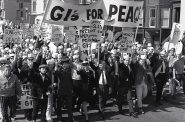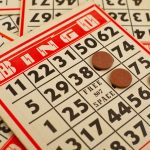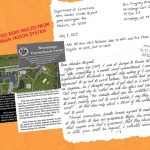Cornell’s “Celestial Navigation of Birds”
Cornell's soaring dreams, compressed and stored in little box at the Milwaukee Art Museum.

Joseph Cornell (American, 1903–1972) Celestial Navigation by Birds, ca. 1958 Mixed media box construction 8 1/2 x 15 1/2 x 3 1/2 in. (21.59 x 39.37 x 8.89 cm) Purchase, Virginia Booth Vogel Acquisition Fund M1989.76 Photo credit P. Richard Eells © The Joseph and Robert Cornell Memorial Foundation / Visual Artists and Galleries Association, Inc. (VAGA)
Go to the Milwaukee Art Museum, pick a work, stand before it for a long time. Tell us what you see. TCD’s One Piece at a Time series began with that thought in the summer of 2010. TCD senior editor Tom Strini handled the One-Piece duties then and in 2011. This summer, we have a variation. In the winter and spring, Strini worked with a class of graduate students in art at UWM. They did the One Piece drill at the Milwaukee Art Museum, wrote draft essays, then survived a writer’s boot camp with Strini. We’re publishing the results, one piece at a time. Here is Gregory Martens‘ contribution.
These simple objects in The Celestial Navigation of Birds reside in a tiny two-story room, painted white. Two horizontal metal rods serve as tracks for the two blue orbs. The tableau looks slightly delicate. The glasses are slender and the balls might roll. But the construction looks sturdy. If the value is not in the contents, it might be in their placement or even their symbolism.
Joseph Cornell (1903-1972) built dreamy little worlds into boxes ever since the days of the Surrealist collage artists. He invites us to step inside and experience our version of the dream. We must become detectives and try to unwind the mystery of The Celestial Navigation of Birds.
Dreams need to be interpreted. A prime clue is the series of six faded blue, circular maps pasted on the upper wall. They might be navigation diagrams, but they also look like miniature gun targets. The two blue balls resemble the earth, or planets. The blue marble makes the ninth blue circle Cornell tucked neatly into this box. The five glasses have circular rims, and the seashell is a natural spiral. Circles are everywhere. Cornell’s acute sense of presentation starts to take shape as soon as you see that.
The postage stamp, from Mozambique, offers another clue. It bears a picture of a monarch butterfly. The butterfly, a frail and weightless transcontinental commuter, migrates along with birds. What do birds think about when they fly? What do they see? The invisible force of air currents, the circular horizon of the ever-present sky, and the vastness of the land and water below are systems that can be represented as circles and spheres. Cornell might be dreaming about birds navigating the Earth, sea, and sky; he might be dreaming he could fly with them, and that we might join him.
The two wooden objects, a straight gear sector and a piece of dry-rotted tree, are placed left and right in the glasses. They are not circular, but they may allude to circular systems: One man-made and one natural, one formed by saw and chisel and the other by wind and water. Both may represent larger systems – the course of industry and the cycle of nature.
Cornell was a homebody and rarely traveled, but he filled his box with symbols of longing, freedom, and flight. Perhaps he could only travel while he dreamed and built The Celestial Navigation of Birds to catch and hold the dream.
Previously this summer: Julie Rogers on Tara Donvan’s Bluffs; Emily Scheider on Chuck Close’s Nancy; Matthew W. Lee on Cow Herd at Lake Starnberg; Corbett Toomsen on Henry Vianden’s Landscape with Mountains and River; Brooklyn Henke on Caillebotte’s Boaters on the Yerres; Joe Grennier on Warhol’s Brillo Box; Eric Roman Beining on Torso of a Male Athlete; Aneesha Baldeosingh on Jules Olitski’s Heat Resistance.
Get more out of TCD. Visit our User Guide/FAQ.
Art
-
Winning Artists Works on Display
 May 30th, 2024 by Annie Raab
May 30th, 2024 by Annie Raab
-
5 Huge Rainbow Arcs Coming To Downtown
 Apr 29th, 2024 by Jeramey Jannene
Apr 29th, 2024 by Jeramey Jannene
-
Exhibit Tells Story of Vietnam War Resistors in the Military
 Mar 29th, 2024 by Bill Christofferson
Mar 29th, 2024 by Bill Christofferson




















Your future as a writer is very bright, sir.